Fig.1-25 Thermal transient margin evaluation technique

Fig.1-26 RV outlet nozzle thermal stress analysis result
To develop plant technologies for safe and reliable operation of "MONJU" and to further expand the technologies for design optimization of future FBR plants, we have evaluated the design technique applied to "MONJU" by using the measurement data obtained through actual operation.
In " MONJU" , the coolant sodium temperature heated by the reactor core increases up to 500°C or more. The difference in temperature of coolant sodium between reactor inlet and outlet exceeds 100°C in "MONJU". Therefore, the integrity of the equipment against reactor trips is verified by examining the influence of severe thermal transients. This paper clarifies the realistic thermal transient of the reactor trip of the actual plant, and evaluates the design margin. Fig.1-25 is an outline of the thermal transient margin evaluation technique.
In a reactor trip test at 40% power capacity, coolant temperature change at the reactor vessel (RV) outlet was faster than the pre-test forecast. And, the feed water temperature change at the evaporator (EV) was higher than the pre-test forecast.
Analysis of the coolant temperature behavior at the RV outlet confirmed the influence of the flow conditions of the low-temperature and the high-temperature sodium that passes through the RV outlet from the upper reactor core. Then, a model of the thermal-hydraulic analysis code was developed with finer partitioning of the area etc. By these improvements, coolant temperature change at the RV outlet was more accurately simulated. In addition, coolant temperature change at RV outlet due to a reactor trip at rated power was simulated by the same code. Fig.1-26 shows thermal stress analysis of RV outlet nozzle based on the simulated temperature and flow rate changes and the design analysis. The actual thermal stress was less than the design analysis result, by a margin of about 50%.
Moreover, to reproduce better the phenomenon of the high temperature steam flowing into EV feed water inlet, we added a backflow analysis function to this code. By these improvements, EV feed water inlet temperature behavior was simulated more accurately than before. In addition, EV feed water inlet temperature change due to a reactor trip at rated power was simulated by the same code. By thermal stress analysis of the EV feed water tube sheet based on simulated temperature and flow rate changes, we confirmed that the EV feed water tube sheet had enough margin in its fatigue accumulation coefficient, well below its limit value of 1.0.
We will use the improved thermal-hydraulic analysis code and the thermal transient margin evaluation results in the operating plan and the forecast analysis for our next test. Moreover, we plan to advance the design technology steadily, based on the real data obtained from the trial operation, for safe and steady plant operation and development of an FBR commercial reactor.